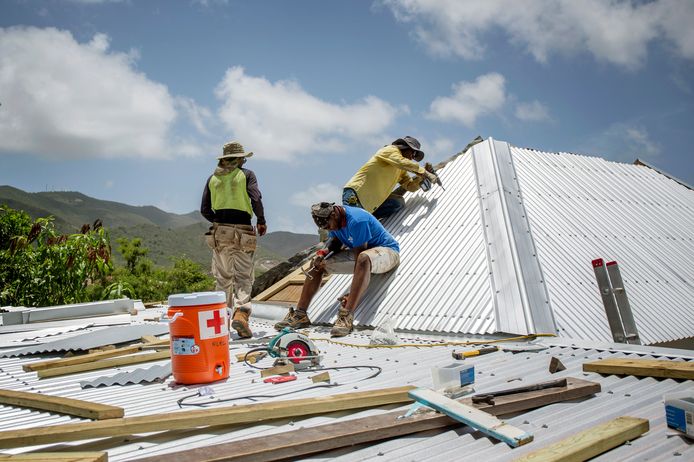After hurricane Irma, corona Sint Maarten plunges into an even greater crisis. Exactly three years after hurricane Irma devastated a large part of Sint Maarten, the Antillean island seemed to have slowly recovered. The reconstruction was well advanced. Until the corona virus plunged the residents into a new, bigger crisis. They wait with fear and trembling for a new hurricane season. Anyone who drives over Sint Maarten now sometimes sees traces of the devastating hurricane Irma. Here and there are still damaged houses and buildings and the airport has not yet been completed. But a lot has already been built up and the island is beautifully green again.
Irma, who swept across the island with wind speeds of 300 kilometers per hour on September 6, 2017, destroyed 91 percent of the buildings and left the residents unsettled. In recent years a lot of work has been done on the reconstruction of the island. The question is how long that will last.
Hurricane season
The hurricane season is in full swing again, even more active than three years ago. Tropical storms and hurricanes, which are named according to the letters of the alphabet every year, follow each other in rapid succession. While the Caribbean was in a storm with the letter ‘i’ (Irma) around this day in 2017, a storm with the letter ‘p’ (Paulette) is already approaching.
Wim de Visser, education advisor, keeps an eye on the weather forecasts and reports from the National Hurricane Center every day. “It’s a Russian roulette every year. We look forward to the coming weeks with fear and trembling. If another severe hurricane comes, we will lose everything we have now built. Then we are back to square one. The economy is not strong enough to bear another disaster. ”
After Irma, the Netherlands made more than half a billion euros available for reconstruction. A national fundraising campaign via Giro 5125 raised nearly 20 million euros.
Food stamps
Immediately after the disaster, the Red Cross provided emergency aid (drinking water, food and tarpaulins) with the donated money. More than 4000 families received food stamps and 3000 students were provided with school meals.
In addition, roofs, windows and doors were repaired at 675 houses. Architects and engineers made an inventory of what was needed and residents were given material to repair the damage themselves or could call on construction workers.
Roof and window structures have been improved to make them more resistant to a hurricane. The Red Cross offered workshops on roof repair and maintenance. With money from the World Bank, another 150 houses can be repaired this year.
Pride
“I am proud of what we have achieved in three years,” said Fanny de Swarte, head of the Red Cross reconstruction mission on Sint Maarten. “Much has been restored. But there are still houses waiting to be repaired. ”
Sometimes it is too slow, in the eyes of the residents. De Swarte understands that. “But after the fireworks disaster in Enschede, it also took ten years for the district to be built up. This disaster has affected the entire island. ”
A lack of experienced and expert manpower on the island is causing delays. “There are not many architects and engineers in a population of 40,000 people. We had to find and train people ourselves. ”
Workers in the tourist sector, who were in disaster after the disaster, have been retrained to become construction workers, air conditioning technicians or bakeries. In this way, people who have lost their jobs can still earn a living.
In the long term, the Red Cross will start projects to get social life going. Some outdoor areas have been renovated so that people can meet again. In schools, the organization will prepare children better for a disaster like Irma.
Scrambled up
Six months ago, Sint Maarten seemed to have recovered. Last winter cruise ships docked again, hotels were full and there were plans for new hotels. The corona crisis has brought the island, which mainly depends on tourism, back to square one.
This summer, the hotels were only 20 percent occupied. Discos, bars and coffee houses will remain closed this month. Many companies are bankrupt. Schools have been closed since March. Resources are limited to provide digital homeschooling for everyone.
Government income from taxes – normally 10 million euros per month – has been halved. The Netherlands only wants to borrow money under strict conditions.
Make sense of life
“Before the corona crisis started, there were tourists again and we were reasonably back to normal,” says De Swarte. “Economic activities got going again. Restaurants and businesses reopened, people had a sense of life again. Now there is another major economic blow. That cuts in. ”
The residents, who have not yet recovered from Irma’s trauma, have a new, greater concern. The Red Cross has used a small part of the Irma funds for food aid in the corona crisis.
Wim de Visser wonders how long the island will continue to do so. The money pots are running out. “Without corona, the reconstruction was on schedule. Irma was a storm that disappeared again. Everything was in ruins, but we were able to rebuild it. Corona is a long-lasting, invisible hurricane that passes over us and we don’t know when it will end. ”
Corona is a long-lasting, invisible hurricane that passes over us
Wim de Visser
Six months after Irma, De Visser bought a new house. He learned from 2017. The days after the disaster he was without water and electricity. His new house has a good-sized generator and hurricane screens. “I am confident that the vast majority of people are now better prepared.”
The Red Cross is also preparing for exciting weeks. “We wait with a squeezed buttocks”, says De Swarte. “It is an unprecedentedly active season. We have already had some tropical storms over us. We hold our hearts. ”
https://www.ad.nl/buitenland/na-orkaan-irma-stort-corona-sint-maarten-in-nog-grotere-crisis~a449ae28/?referrer=https%3A%2F%2Fdrimble.nl%2Fdossiers%2Fmulticultureel%2Fantillen%2F70796546%2Fna-orkaan-irma-stort-corona-sint-maarten-in-nog-grotere-crisis.html

